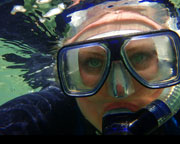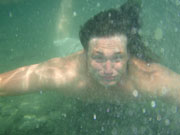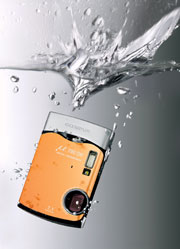Olympus µ 790 SW / Stylus 790 SW
-
-
Written by Gordon Laing
Olympus
µ
790 SW / Stylus 790 SW Verdict
The Olympus µ / Stylus 790 SW is certainly a unique compact camera, being able to happily operate underwater at depths up to 3m without the need, bulk or expense of a specialist housing. You can literally just dive in and keep taking photos. It’s also tougher than the average compact, and so long as you don’t mind a few cosmetic dings, can survive drops onto hard surfaces from 1.5m. It’s additionally freeze-proof to minus 10 degrees Celsius.
This gives the 790 SW a great deal of flexibility and its owner an equal amount of reassurance. Here’s a camera you can confidently take not just underwater, but also to a pool side or ski resort, without worrying about splashes or snow. It’ll also handle knocks and drops which, along with water-resistance, makes it an ideal camera to hand over to the kids.
 |
 |
In use these aspects really do work. We gave the 790 SW a short spell in a domestic freezer (admittedly colder than minus 10 degrees), dropped it onto carpet, gravel and stony surfaces from head-height and submerged it for three quarters of an hour in the chilly waters of Queenstown’s Lake Wakatipu. The camera survived them all, although did pick up a few small scratches.
It’s not perfect under these conditions though. The screen proved hard to view underwater and it’s ironic that a disposable camera with a hole for a viewfinder often proved easier for framing.
Don’t expect miracles from the battery either – ours was exhausted after 45 minutes underwater, although it was pretty constant use and the water was chilly. That said, if you are planning on a once-in-a-lifetime trip to a coral reef, you should take spare batteries and work out some means by which you can change them in a dry environment.
These points aside, the 790 SW is undoubtedly a fun camera to use and it’s quite liberating not to worry about it. Unfortunately though its image quality is noticeably below that of other compacts, with significant softening of fine details, especially beyond the lowest ISOs.
We also appreciate the underwater capabilities restrict the optics, but in general use, the 38-114mm range is unremarkable and lacking the wide angle capabilities of several rivals. Then there’s the unforgivable absence of optical or sensor shift anti-shake, which means you’ll be relying on those poor quality high sensitivities to avoid camera shake in dim conditions.
So before wrapping-up, how does the 790 SW measure-up against rivals?
Compared to Pentax Optio W30
 |
Pentax is the only other major manufacturer which produces compacts ready to operate underwater without any further accessories. The Optio W30 is its latest model, offering the same 7.1 Megapixel resolution and 38-114mm 3x optical range as the Olympus 790 SW. It also operates at the same depth of up to 3m for two hours.
The Pentax has a lower resolution 115k pixel screen, but many will prefer its use of SD memory to the less common xD format on the Olympus. Ultimately though the specifications are very similar, so it’s a case of weighing up the look, feel and price of both cameras. See the latest Pentax compact cameras.
Compared to Panasonic Lumix DMC-FX33
 |
For roughly the same money as the Olympus, you could alternatively buy the Panasonic Lumix DMC-FX33. In its favour the FX33 has an extra Megapixel, optical stabilisation, much wider-angle 28mm-equivalent coverage, Panasonic’s excellent Intelligent Auto and widescreen movie modes, and better overall image quality.
Dunk it in the water though and you’re unlikely to have a happy camera. So if you want a great overall compact, the FX33 is ideal, but if you need built-in underwater capabilities, then you’ll want the Olympus or Pentax. See our Panasonic Lumix DMC-FX33 review for more details.
Compared to Canon Ixus 860IS / PowerShot SD870
 |
The Canon Ixus 860IS / PowerShot SD870 is one of the best compacts we’ve tested and shares many of the same advantages as the Panasonic FX33: namely, an extra Megapixel, optical stabilisation and much wider-angle 28mm-equivalent coverage, along with a bigger 3in screen, superior handling and better image quality.
If you’re after an excellent compact and don’t mind spending the extra, the Canon is definitely worth considering, but like the Panasonic, it won’t survive submersion without an underwater housing. So again you have to weigh-up how you’ll be using the camera. See our Canon Ixus 860IS / PowerShot SD870 review for more details.
Olympus
µ
790 SW / Stylus 790 SW Final Verdict
The Olympus 790 SW lets you confidently take photos in situations where you’d worry about other cameras, or simply be unable to take them at all. Raining? No problem. Splashes from a canoe or kayak? Fine. Dropped in the snow while skiing or boarding? No sweat. Complete submersion underwater? Why not?
 |
This makes it the ultimate type of camera for anyone who works or plays in adventurous environments, but it’s equally ideal for kids – or indeed anyone – who might knock a camera around. It’s certainly very liberating to have a camera you can leave by a poolside without worries of splashes – or indeed even take in the water with you.
But, and it’s a big but, the image quality isn’t anything to write home about. We’ve tested compacts which cost the same and deliver much better quality, while also boasting wider angle lenses and proper anti-shake facilities. So if you’re after the best image quality and photographic features, and aren’t bothered about the tough or waterproof aspects of the 790 SW, we’d recommend buying a different camera. See our Compact Buyers Guide for the best models around right now.
But if you’re the kind of person who’d love to take photos in wet or snowy conditions but reluctantly leaves your camera at home for safety, then the Olympus 790 SW is definitely one to consider. The quality may not be the best around, but it simply allows you to take photos in conditions where other cameras would fail. Outdoor and adventure sports enthusiasts will forgive the downsides and instead embrace the picture-taking opportunities of a camera that operates in the same conditions they do. As such it comes Recommended, but only for those who really need the tough and underwater capabilities.
Bad points | Scores (relative to 2007 compacts) |
 | ||
Build quality: Image quality: Handling: Specification: Value:
Overall: | 20 / 20 13 / 20 16 / 20 16 / 20 17 / 20
82% | |||




